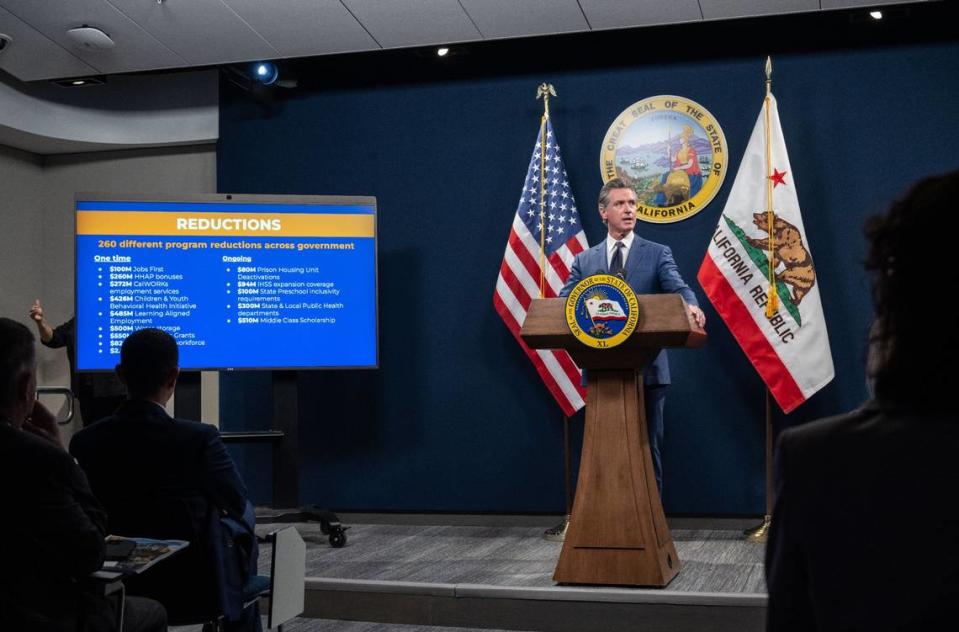California Gov. Gavin Newsom speeds up money for mental health ballot measure he championed. Here’s how
- Oops!Something went wrong.Please try again later.
More than $3 billion will be available in July to build or refurbish mental health treatment centers as part of an accelerated release of money from a voter-approved bond measure, a step California Gov. Gavin Newsom is taking as part of his strategy to curb homelessness and address mental health.
Standing at a podium with a sign that read “Treatment not tents” outside a mental health facility tucked in a hillside in Redwood City, Newsom announced the availability of the money and promised quick decisions on development applications, saying that the state is “at a hinge moment.”
“I’ve never been more enthusiastic about our prospects to actually make a dent and address the issues of what’s happening on the streets and sidewalks in the state than I am today,” the governor said during a mid-afternoon Tuesday press conference., adding that the next two to three years will be “transformational.”
“We’ve addressed a lot of the barriers, a lot of the issues we have struggled with for decades in the state of California,” Newsom said., adding that “No one reform will achieve the results that people demand and we all expect. “
While Newsom promised quick evaluation of applications by an internal “strike team” for the needed housing under Proposition 1, the governor did not specify how soon that housing would come on line saying, “those dollars will be out the door around the new year.”
The move fast tracks use of money for Proposition 1, the measure slated to pump nearly $6.4 billion toward developing more such facilities.
Newsom also announced that launch of a new website, MentalHealth.ca.gov, to serve as a one-stop source for people in need of mental health services. Another version of the website will show how counties are faring and to serve as a transparency dashboard for the public.
He chose San Mateo County as his backdrop for Tuesday’s announcement because the county is an early adopter of the CARE Act, which Newsom championed. The bond money will provide housing that would allow CARE Court – a statewide system of county mental health courts meant to compel treatment for those with severe mental illnesses – to work.
Newsom exhorted other counties to move and “demonstrate the same urgency” on homelessness reforms and initiatives, also touting conservatorship changes that his administration has worked to advance. He noted that the state’s Mental Health Services Act was passed two decades ago “for a world that no longer exists.”
“We can’t do this alone,” the governor said. “The state’s vision is realized at the local level.”
The money from Proposition 1, approved by voters by only a narrow margin of 50.2% to 49.8%, will target those who are in crisis or experiencing chronic homelessness and for veteran housing.
Budget revisions
Tuesday’s announcement came on the heels of the governor unveiling his revised budget Friday and a day before his trip to the Vatican to speak at a papal summit on climate change.
During his budget revision, the governor proposed trimming $260 million from the next round of Homeless Housing, Assistance and Prevention program, or HHAP, funding. It’s unclear if lawmakers and the governor will provide funding for another round of the program.
The proposal drew immediate backlash.
San Diego Mayor Todd Gloria, who chairs the Big City Mayors coalition, said in a statement that homelessness in California would only worsen if the program is cut.
“If the state wants to reverse the trend of more people falling into homelessness, cutting off funding for programs that are keeping tens of thousands of people indoors and off the streets isn’t the way to do it,” Gloria said..
More than 181,000 Californians experienced homelessness on a given night in 2023, according to the U.S. Department of Housing and Urban Development.
However, the state Legislative Analyst’s Office, which among other functions provides nonpartisan analysis of the budget for the Legislature, has estimated the Proposition 1 bond would build up to 4,350 housing units, with 2,350 set aside for veterans, helping a sliver of the state’s overall homeless population.
“The number of housing units built by the bond would reduce statewide homelessness by only a small amount,” the LAO noted in its analysis of Proposition 1.
While the governor’s revised budget calls for trimming millions in supplemental funding from HHAP, $1 billion is still in an ongoing round of funding with no further commitment to another round.
When asked by the Sacramento Bee about the small subset of population that the proposition funding is aimed at and whether he expects to continue HHAP funding, the governor said “in an ideal world, he’d love to” and would work with legislators.
“The Legislature in their wisdom will make that determination on the basis of what they believe should be prioritized in this budget,” he said. “And they can make a determination if they want to continue to appropriate levels that we have seen in the past.”
Among those speaking out after the governor proposed the $260 million cut on Friday was San Diego Mayor Todd Gloria, who chairs the Big City Mayors coalition, who said “California’s homelessness problem will only get worse” if the program is cut.
The governor’s homelessness agenda
Just weeks ago, Newsom in a virtual announcement renewed his call for accountability from cities and counties that receive homelessness funding after an audit showed the state is not adequately tracking the effectiveness of programs meant to help the unhoused.
Newsom has banked his years-long homelessness and mental health care reform strategy on Proposition 1, which reconfigures the California Mental Health Services Act to redirect the majority of its funding from the counties to the state.
Opponents of Proposition 1 have included not only Republican lawmakers and conservative-leaning county boards of supervisors, but also disability rights activists and some mental health groups. Critics warned that the measure would lead to a top-down, one-size-fits-all approach to mental health care in the state.
An overwhelming majority – 96% – of Californians believe homelessness to be at least somewhat of a problem in the state, according to a recent survey from the Public Policy Institute of California.
Planned behavioral health milestones
Last October, Newsom stood at a podium with a “Treatment Not Tents” sign after having signed a pair of bills that paved the way for funding and policy changes on the primary election ballot under Proposition 1.
“Today is about holding ourselves to a high level of accountability, a higher level of expectation,” the governor said then.
This ballot measure was part of a broader plan by the governor to address California’s homeless crisis by removing encampments and getting the homeless who were diagnosed with mental illness or substance abuse into treatment programs.
According to the California Health and Human Services Agency, here’s how the $6.38 billion from the Behavioral Health Infrastructure Bond Act – passage of which put Proposition 1 before voters – will be spent:
All of the money will be used to construct, acquire, and rehabilitate more than an estimated 6,800 treatment beds and 26,700 out-patient treatment slots; 4,350 permanent supportive housing units, with 2,350 of those set-aside for veterans
$4.4 billion will go toward grants to public or private entities for behavioral health treatment and residential settings, including $1.5 billion to be awarded only to counties, cities and tribal entities, with $30 million set aside for tribes
$1.065 billion in housing investments for veterans experiencing or at risk of homelessness who have behavioral health challenges; $922 million for housing investments for persons experiencing or at risk of homelessness who have behavioral health challenges.
Modeled after the Behavioral Health Continuum Infrastructure Program (BHCIP), which the Department of Health Care Services was authorized through 2021 legislation to establish with $2.2 billion “to construct, acquire, and rehabilitate real estate assets or to invest in needed mobile crisis infrastructure to expand the community continuum of behavioral health treatment resources.”
The state Department of Health Care Services is holding listening sessions to hear from the public and others, with bond funding availability starting in the summer. Starting in early 2025 policy and guidance will be released in phases, with fiscal transparency and data reporting requirements going live in July 2026.


